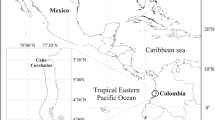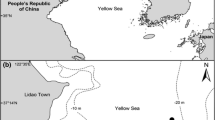Abstract
The diets of one ray species (Rhinobatus typus) and three shark species (Carcharhinus cautus, Negaprion acutidens, Rhizoprionodon acutus) undergo size-related changes and differ among these species in the nearshore waters of a large subtropical embayment (Shark Bay) in which these elasmobranchs are abundant, thereby reducing the potential for competition for food within and among these four species. R. typus fed almost exclusively on penaeid prawns and portunid crabs, which is reflected in its narrow dietary breadth, whereas different species of teleosts constituted a major component of the diets of each size class of the three shark species. The prey consumed by the three shark species was diverse, with representatives of 15 teleost families being consumed by C. cautus and substantial volumes of cephalopods being ingested by that species and R. acutus. The pronounced differences in the diet of the single ray species and three shark species reflect differences between a bottom-dwelling and more pelagic life, and between modes of feeding and relative mouth sizes. The relative contributions of the different species of teleost to the diets of the three shark species varied. Thus, although each of these species fed on atherinids, labrids and sillaginids, C. cautus also consumed substantial amounts of platycephalids and terapontids and R. acutus and N. acutidens also ingested considerable amounts of clupeids. Furthermore, R. acutus, which is the only one of the four species that typically occurs over seagrass, was the only species that fed on the centropomid Psammoperca waigensis, which is very abundant in seagrass meadows. However, the sparid Rhabdosargus sarba, which lives in unvegetated areas, was never ingested by R. acutus, but was consumed by C. cautus and N. acutidens. As the individuals of R. typus increased in size, they progressively consumed proportionately smaller volumes of the penaeid prawns Penaeus merguiensis and Melicertus latisulcatus and relatively greater volumes of the portunid crab Portunus pelagicus, which is slightly larger and has a harder exoskeleton. In addition to teleosts, large C. cautus ingested substantial volumes of portunid crabs and ophidian reptiles, presumably sea snakes, while large N. acutidens also fed on the ray R. typus.





Similar content being viewed by others
References
Anon. (2001) The world heritage list. United Nations Educational, Scientific and Cultural Organisation, cited 18 September 2001. MACROBUTTON HtmlRes Anchor http://www.unesco.org/whc/heritage.htm
Babel JS (1967) Reproduction, life history, and ecology of the round stingray, Urolophus halleri Cooper. Calif Dep Fish Game Fish Bull 137:1–104
Blaber SJM, Brewer DT, Salini JP, Kerr J (1990) Biomasses, catch rates and abundances of demersal fishes, particularly predators of prawns, in a tropical bay in the Gulf of Carpentaria, Australia. Mar Biol 107:397–408
Brewer DT, Blaber SJM, Salini JP (1991) Predation on penaeid prawns by fishes in Albatross Bay, Gulf of Carpentaria. Mar Biol 109:231–240
Chan TY (1998) Shrimps and prawns. In: Carpenter KE, Niem VH (eds) FAO species identification guide for fishery purposes. The living marine resources of the western Central Pacific, vol 2. Cephalopods, crustaceans, holothurians and sharks. FAO, Rome, pp 851–971
Clarke KR (1993) Non-parametric multivariate analysis of changes in community structure. Aust J Ecol 18:117–143
Clarke KR, Gorley RN (2001) Primer v5: user manual/tutorial. Primer-E, Plymouth
Compagno LJV (1984) FAO species catalogue, vol 4. Sharks of the world. An annotated and illustrated catalogue of shark species known to date, part 2. Carcharhiniformes. FAO Fish Synop 125:251–655
Cortes E (1999) Standardized diet compositions and trophic levels of sharks. ICES J Mar Sci 56:707–717
Ebert DA, Cowley PD, Compagno LJV (1991) A preliminary investigation of the feeding ecology of skates (Batoidea: Rajidae) off the west coast of southern Africa. S Afr J Mar Sci 10:71–81
Edgar GJ, Shaw C (1995) The production and trophic ecology of shallow-water fish assemblages in southern Australia. II. Diets of fishes and trophic relationships between fishes and benthos at Western Port, Victoria. J Exp Mar Biol Ecol 194:83–106
Ellis JR, Pawson MG, Shackley SE (1996) The comparative feeding ecology of six species of shark and four species of ray (Elasmobranchii) in the north-east Atlantic. J Mar Biol Assoc UK 76:89–106
Hynes HBN (1950) The food of fresh-water sticklebacks (Gasterosteus aculeatus and Pygosteus pungitius), with a review of methods used in studies of the food of fishes. J Anim Ecol 19:36–58
Hyslop EJ (1980) Stomach content analysis—a review of methods and their application. J Fish Biol 17:411–429
Jenkins GP, May HMA, Wheatley MJ, Holloway MG (1997) Comparison of fish assemblages associated with seagrass and adjacent unvegetated habitats of Port Phillip Bay and Corner Inlet, Victoria, Australia, with emphasis on commercial species. Estuar Coast Shelf Sci 44:569–588
Kailola PJ, Williams MJ, Stewart PC, Riechelt RE, McNee A, Grieve C (eds) (1993) Australian fisheries resources. Bureau of Resource Sciences, Canberra
Kyne PM, Bennett MB (2002) Diet of the eastern shovelnose ray, Aptychotrema rostrata (Shaw & Nodder, 1794), from Moreton Bay, Queensland, Australia. Mar Freshw Res 53:679–686
Linke TE, Platell ME, Potter IC (2001) Factors influencing the partitioning of food resources among six fish species in a large embayment with juxtaposing bare sand and seagrass habitats. J Exp Mar Biol Ecol 266:193–217
Lyle JM (1987) Observations on the biology of Carcharhinus cautus (Whitley), C. melanopterus (Quoy & Gaimard) and C. fitzroyensis (Whitley) from northern Australia. Aust J Mar Freshw Res 38:701–710
Lyle JM, Timms GJ (1987) Predation on aquatic snakes by sharks from northern Australia. Copeia 1987:802–803
Marshall S, Elliot M (1997) A comparison of univariate and multivariate numerical and graphical techniques for determining inter- and intraspecific feeding relationships in estuarine fish. J Fish Biol 51:526–545
Moss SA (1972) The feeding mechanism of sharks of the family Carcharhinidae. J Zool (Lond) 167:423–436
Motta PJ, Wilga CD (2001) Advances in the study of feeding behaviors, mechanisms, and mechanics of sharks. Environ Biol Fishes 60:131–156
Motta PJ, Tricas TC, Hueter RE, Summers AP (1997) Feeding mechanism and functional morphology of the jaws of the lemon shark Negaprion brevirostris (Chondrichthyes, Carcharhinidae). J Exp Biol 200:2765–2780
Pielou EC (1966) Shannon’s formula as a measure of species diversity: its use and misuse. Am Nat 100:463–465
Piet GJ, Guruge WAHP (1997) Diel variation in feeding and vertical distribution of ten co-occurring fish species: consequences for resource partitioning. Environ Biol Fishes 50:293–307
Platell ME, Potter IC (1999) Partitioning of habitat and prey by abundant and similar-sized species of the Triglidae and Pempheridae (Teleostei) in coastal waters. Estuar Coast Shelf Sci 48:235–252
Platell ME, Potter IC (2001) Partitioning of food resources amongst 18 abundant benthic carnivorous fish species in marine waters on the lower west coast of Australia. J Exp Mar Biol Ecol 261:31–54
Platell ME, Potter IC, Clarke KR (1998) Resource partitioning by four species of elasmobranchs (Batoidea: Urolophidae) in coastal waters of temperate Australia. Mar Biol 131:719–734
Ross ST (1986) Resource partitioning in fish assemblages: a review of field studies. Copeia 1986:352–388
Salini J, Blaber SJM, Brewer DT (1992) Diets of sharks from estuaries and adjacent waters of the north-eastern Gulf of Carpentaria, Australia. Aust J Mar Freshw Res 43:87–96
Schafer LN, Platell ME, Valesini FJ, Potter IC (2002) Comparisons between the influence of habitat type, season and body size on the dietary compositions of fish species in nearshore marine waters. J Exp Mar Biol Ecol 278:67–92
Simpfendorfer CA (1998) Diet of the Australian sharpnose shark, Rhizoprionodon taylori, from northern Queensland. Mar Freshw Res 49:757–761
Simpfendorfer CA, Goodreid AB, McAuley RB (2001a) Diet of three commercially important shark species from Western Australian waters. Mar Freshw Res 52:975–985
Simpfendorfer CA, Goodreid AB, McAuley RB (2001b) Size, sex and geographic variation in the diet of the tiger shark (Galeocerdo cuvier) in Western Australian waters. Environ Biol Fishes 61:37–46
Somerfield PJ, Clarke KR (1997) A comparison of some methods commonly used for the collection of sublittoral sediments and their associated fauna. Mar Environ Res 43:145–156
Stevens JD, McLoughlin KJ (1991) Distribution, size and sex composition, reproductive biology and diet of sharks from northern Australia. Aust J Mar Freshw Res 42:151–199
Travers MJ, Potter IC (2002) Factors influencing the characteristics of fish assemblages in a large subtropical marine embayment. J Fish Biol 61:764–784
Walker DI (1989) Regional studies—seagrass in Shark Bay, the foundation of an ecosystem. In: Larkum AWD, McComb AJ, Shepherd SA (eds) Biology of seagrasses. Elsevier, New York
Werner EE, Gilliam JF (1984) The ontogenetic niche and species interactions in size-structured populations. Annu Rev Ecol Syst 15:393–425
White WT, Hall NG, Potter IC (2002) Size and age compositions and reproductive biology of the nervous shark Carcharhinus cautus in a large subtropical embayment, including an analysis of growth during pre- and postnatal life. Mar Biol 141:1153–1164
Wilga CD, Motta PJ (1998) Feeding mechanism of the Atlantic guitarfish Rhinobatos lentiginosus: modulation of kinematic and motor activity. J Exp Biol 201:3167–3184
Acknowledgements
Gratitude is expressed to D. Fairclough, A. Hesp, S. de Lestang, M. Taylor, D. Thorburn and many others for help with field sampling. Financial support was provided by Murdoch University, the Western Australian Department of Fisheries and the Australian Fisheries Research and Development Corporation. Animal usage was approved by the Murdoch University Animal Ethics Committee (permits 634R and 860R).
Author information
Authors and Affiliations
Corresponding author
Additional information
Communicated by G.F. Humphrey, Sydney
Rights and permissions
About this article
Cite this article
White, W.T., Platell, M.E. & Potter, I.C. Comparisons between the diets of four abundant species of elasmobranchs in a subtropical embayment: implications for resource partitioning. Marine Biology 144, 439–448 (2004). https://doi.org/10.1007/s00227-003-1218-1
Received:
Accepted:
Published:
Issue Date:
DOI: https://doi.org/10.1007/s00227-003-1218-1




